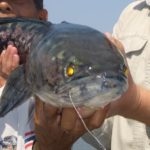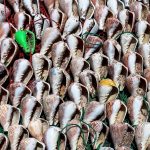In many areas of the biggest Cambodian lake, its tributary river, and the Mekong flood plains, permanent bamboo fence fish traps, or, more appropriately, catching structures, are erected and operated.

The leader fence, which guides fish into the trap’s inner compartments, can be up to 500 meters long. The inner compartments consist of one or more pre-catching rooms, leading to one or more heart-shaped catching rooms. At the end of the last catching room, a horizontal bamboo fish-holding chamber is located, and it will be cleaned out regularly.

Such bamboo fence traps catch fish and water snakes, complicating fish removal. But locals are ruthless toward snakes, and all are killed immediately. In some areas, they serve as fodder for crocodile farms.
Lesson learned about bamboo fence fish traps in Cambodia
- These fish traps are erected by concession holders of fishing blocs on Tonlé Sap Lake. Also – in smaller versions – by small-scale fishermen in areas outside of concessions.
- There are widespread frictions between concession holders and small-scale fishermen at this lake. This is due to economic interests on the one hand and the need for the survival of impoverished families on the other.
- Bamboo fence traps can be easily pulled and re-erected in receding waters or flood plains.
- When cleaning out these structures at the catching end, special care must be taken not to be bitten by water snakes.
.





